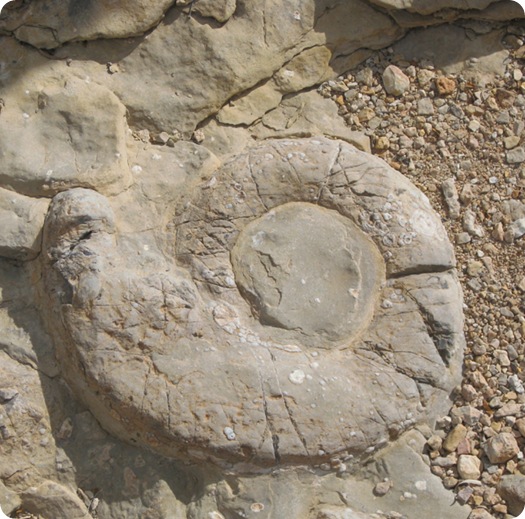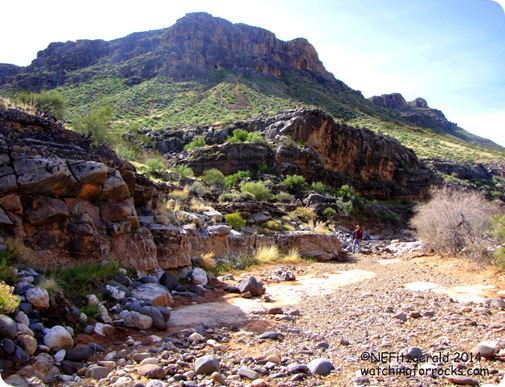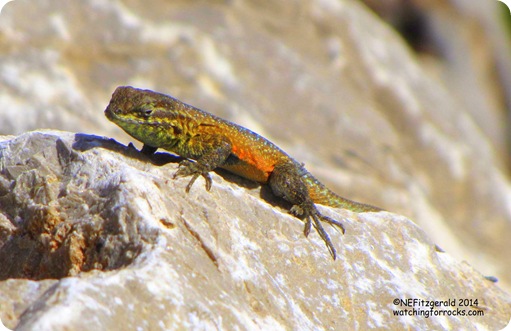Not too long ago a friend emailed me an intriguing image.
What’s this? He inquired.
Well, jeez, I replied. That’s an ammonite! Where in the world did you find that?
 |
|||
| An ammonite from NW Arizona |
Now, I don’t remember ever seeing an ammonite in the field, and I’ve been hiking around Utah and Arizona for decades. Ammonites are an extinct group of invertebrates of the class Cephalopoda that are more closely related to octopus and squid than they are to the living Nautilus species which they somewhat resemble. This was beyond exciting! I did a little dance and came up with a scheme to go see that little beauty for myself.
Coincidentally, it was during this quest for the elusive ammonite that I would ascertain a universal truth, a geologic certainty right up there with Steno’s Principle of Original Horizontality and Law of Superposition.
They don’t call it fossil hunting for nothing!
I soon learn that this ammonite was discovered the previous day, while some folks were hiking in Black Rock Canyon in the Virgin River Gorge. More to the point, it had been stumbled over and gone unnoticed by nearly every single person in the group (gasp!) until one particularly vigilant hiker (I’ll call her Judy, since that’s her name) gave a shout out.
Hey! Come look at this!
Photos were snapped. GPS readings were taken. The location “a short distance up a side canyon below a heart–shaped cave turned clockwise 90 degrees” was noted. After learning that my dear friend Judy had indeed been the first hiker to notice the ammonite, I think to myself “Well… this should certainly be easy enough to find. Judy will know exactly where to go! We have a gps coordinate. All we will need to do is to find that heart–shaped canyon turned on its side and bada–bing! We would find ourselves admiring a cool fossil specimen before anyone could even say “Permian limestones!”
If only it were that easy. Let me stress once again that they don’t call it fossil hunting for nothing.
 |
| Permian rocks everywhere – limestones overlie sandstone in Black Rock Canyon |
I mount the expedition. Our plan is for Judy to lead Mr. Ben and me to the exact location of our precious fossil, through the cowpie–strewn and cheatgrass–infested wasteland of Black Rock Canyon. We will travel up–section, from the Queantoweap Sandstone into the younger limestone layers of the Toroweap and Kaibab Formations.
 |
| Mr. Ben hikes up the sandstone wash |
It’s a sunny spring morning as we scramble down an embankment along I-15 and leave the highway noise behind. We look up. We look down. We look left. We look right. We quickly pass small heartless side canyons. Limestone outcrops soon become more numerous and so do the fossils. We press on, fossil hunters on a mission.
 |
| Fossil hash of brachiopods, bryozoans, and crinoid stems |
Soon we spot the canyon below a heart–shaped cave turned clockwise 90 degrees. The limestone outcrops here are full of fossil hash and just beg to be examined. I start scrambling up the side canyon. However, Judy will have none of it.
 |
| Heart shaped cave (dark spot in center of image) high above side canyon – Mr. Ben for scale |
We didn’t go up there! That’s not where it is!
I check the gps latitude/longitude coordinates that were given to me. They look weird. I recognize West, but North looks like some Universal Transverse Mercator coordinate for Pluto. Had I verified my data at home on Google Earth? Of course not! Meanwhile, I am insisting that this has to be the correct canyon while Judy insists, just as vehemently, that no, it doesn’t. Well, she is the one who had been here just a few days before and seen the ammonite, not me. I ease myself back down into the main wash, crushed and disappointed.
Ben, meanwhile, has wandered off to refuel with a bit of lunch. I find him stretched out in the sun on a boulder with some serious fossil hash embedded in it. Shell fragments and imprints of brachiopods, bryozoans, and crinoids stems are noticeable in the blackish brightness.
 |
| A bryozoan? Lots of brachiopod fragments, too. |
Soon we head back down the wash, dejected in our failure to find the ammonite. Judy is apologetic. I amuse myself by photographing desert wildflowers and playing “wait for the lizard to blink.”
 |
| Sego lily – Utah state wildflower |
 |
| Do lizards blink? |
In the meantime, though, some soft sediment deformation in the low sandstone cliffs offers itself up for pondering. Long before this sand lithified (turned to stone), it shifted, possibly due to earthquakes hundreds of millions of years ago. Ben points out interesting stuff and we have a closer look.
 |
| Soft sediment deformation in the Queantoweap Sandstone |
 |
| Soft sediment deformation to the right of Ben’s hat |
 |
| Did you think the hat was floating in mid air? |
Dejected but unwilling to admit defeat, a few days later Ben and I mount yet another expedition in search of the elusive ammonite. Judy declines further anguish and does not go, telling me to text her if we find the dang thing. We recruit someone else to come along on our quest (I’ll call him Tim because, well, that’s his name). Ben figures out the problem with the gps reading for Pluto – N3657.791 should be N36.57.791, a location in northwest Arizona, exactly where it ought to be located: a short distance up a side canyon below a heart–shaped cave turned clockwise 90 degrees.
Ben, Tim, and I shuffle around just above the entrance to the side canyon, hunting for a fossil.
Here it is!
Tim spots the ammonite first (Of course, the new guy finds it!) mere inches (more or less) from where I had stood a few days before, exactly where I had suspected it would be. It isn’t going anywhere soon, though, without several pounds of carefully placed dynamite with which to extract it from the bedrock. We hunt around for a while for other ammonites but none reveal themselves. We then sit for a while and ponder the cliffs on the opposite side of the canyon, and determine that our fossil is in the Lower Permian rocks of the Brady Canyon Member of the Toroweap Formation, around 270–265 million years old.
 |
| The fossil with a proper rock hammer scale |
 |
| Ammonite in red outline with Tim for scale |
 |
| Red arrow points to ammonite. Ben for scale. |
There is no original shell left for us to admire or suture lines to use for positive critter identification. What remains is only a mold with embedded fossil hash. When this animal died hundreds of millions of years ago it settled on the bottom of the shallow Permian sea. Sediment eventually filled the inside of the shell. Over geologic time the original shell has been replaced, leaving only the lithified mold.
It is mere chance and a peculiar set of geologic circumstances that enable what remains of this ancient cephalopod to find itself exposed in a limestone outcrop in remote northwest Arizona, its rough surface smoothed by eons of flash food events, waiting patiently for any 21st century fossil hunter who happens to stumble by and take notice.







